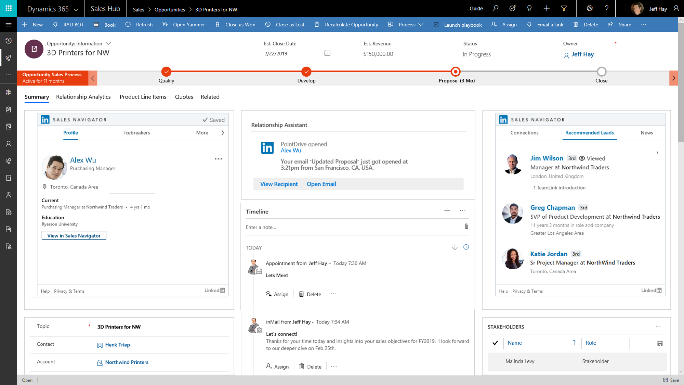When consumers buy goods and services online, these days, there are usually no people involved at all in the sales transaction. From a business perspective, that means you’ll need to ensure the process from online advertising to ordering and delivery is as seamless as possible.
There’s a fantastic array of cost-effective technology designed to automate all of this. But that said, even with these huge advances in technology, the more complex sales still require systems capable of supporting people to maximise their success.
Here’s what key sales solution capabilities to look out for when sales are more complex and people need to be involved.
It’s worth taking a risk
Despite changes in the business landscape, it’s fascinating to see how many companies still get by with Excel and Outlook when it comes to managing their sales reporting and contact management. Not only does this impact productivity, data accuracy and visibility but it gives competitors a chance to get ahead.
Why aren’t all businesses digitising?

In many cases, it’s not the software and its capabilities that restrict a business these days. It’s the ability of the business to understand the possibilities offered by technology advances and their willingness to implement such advances.
A modern customer engagement suite
Today’s customer engagement software can give companies a real helping hand. Take Microsoft Dynamics 365 (D365) Customer Engagement, for example. The solution is a popular option for the following reasons:
1. Leadership acceptance by the analysts
Microsoft is a leader for Sales Force Automation according to Forrester, Gartner and most of the other analysts. The software can support:
- Traditional lead to qualification
- Opportunity to cash scenarios, including full reporting of all activities back and forth with the prospect
- Generation and management of quotes, invoices, products and pricing
2. Seamless social integration with LinkedIn
LinkedIn now offers full two-way integration with the Dynamics platform. Here’s how:
- Account, contact and lead management support – your salespeople and account managers can now keep ahead of any changes as well as connect to important people in clients and prospects. This will enable them to manage clients and sell to them much easier
- Relationship selling - understanding your prospect or client is a lot about understanding not only who they are but where they’re going and the current news about them. LinkedIn surfaces a lot of this information inside Dynamics now in a capability called “Relationship Selling”
- Integration with Talent Management - Microsoft has also integrated LinkedIn with its Talent Management offering. We won’t go into too much depth here so stay tuned for a future post

3. Seamless Outlook integrations
Salespeople live in Outlook and use this from their phone, tablet and laptop. Microsoft has ensured the D365 Sales application looks and runs seamlessly with Outlook across all of these platforms.
Another great benefit is the Application for Outlook doesn’t require any installation (or maintenance). Once D365 is enabled for a user, that user has full seamless integration and tracking between communications with a contact in Outlook and D365.
4. Sales Insights using Business and Artificial Intelligence (BI and AI) tools
D365 Sales comes with an AI feature that analyses the interactions your business is having with customers. For example, the Azure services analyse the emails in your exchange server. This can tell you the depth of conversations which can sometimes give you conversational routes into your client that you may not have known existed.
And it gets better! This feature requires very little work to set up as the AI intelligence is already there. You just switch it on and then use the D365 Sales functionality across your business.
5. PowerBI analytics
Without a doubt, Microsoft’s PowerBI is the most powerful analytical reporting and dashboarding tool we’ve ever seen.
You can very easily display your sales information inside PowerBI and PowerBI dashboards and charts directly inside D365. Microsoft has created a full sales dashboard that you can use immediately. If needed, you can change this to suit whatever you need.
D365 CE can be just the solution sales teams need

In our experience, salespeople often struggle to adopt an automated sales support solution such as those supplied by Microsoft, Salesforce and others.
Adoption of D365 Sales should include the adoption of the critical LinkedIn integrated functions, a fully unified Outlook to Dynamics approach, Sales Insights and PowerBI-based management reporting. Alongside the quality of a product, people will still be one of, if not the most important factors in selling successfully.
More than sales force automation
While a lot of businesses implement sales force automation (SFA) purely to deliver improvements in management reporting, D365 for Sales delivers so much more than that. It’s a platform that can dramatically improve the ability for sales to find leads, manage contacts, increase sales velocity and conversion rates.
It’s critical that the salesperson can see the value this solution can bring to them, as well as the wider value it can bring to the business. For those reasons, the solution must be easy to use and dovetailed into their daily lives.
Targets drive behaviour and we all know most salespeople focus on their ability to hit their sales targets!
With all these extra capabilities, the business will benefit from increased sales velocity and conversion, and much better reporting and accuracy of the sales pipeline.
Learn more about the capabilities of the Customer Engagement platform by downloading our factsheet below.

